Showing Spotlights 129 - 136 of 318 in category All (newest first):
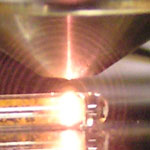 It has been known for several years that carbon nanotubes would heat, ignite and luminesce upon exposure to certain types of electromagnetic radiation, including laser light. However, no one expected any form of fullerenes to do the same thing. Until now. A team at the University of Florida has discovered that functionalized fullerenes heat, ignite, glow and transform into other carbon nanostructures such as carbon nanotubes upon exposure to low-intensity laser light. This is the first time these findings have been published. A possible explanation for the optical heating and ignition phenomena that have been observed is a distortion of the symmetrical cage structure of the fullerenes.
It has been known for several years that carbon nanotubes would heat, ignite and luminesce upon exposure to certain types of electromagnetic radiation, including laser light. However, no one expected any form of fullerenes to do the same thing. Until now. A team at the University of Florida has discovered that functionalized fullerenes heat, ignite, glow and transform into other carbon nanostructures such as carbon nanotubes upon exposure to low-intensity laser light. This is the first time these findings have been published. A possible explanation for the optical heating and ignition phenomena that have been observed is a distortion of the symmetrical cage structure of the fullerenes.
Mar 17th, 2010
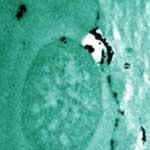 Some scientists believe that, with the increased mass production of engineered nanoparticles like carbon nanotubes, there is a realistic chance for these particles to interact with water, soil and air, and subsequently enter the food chain. However, understanding the behavior and impacts of nanomaterials in the environment and in human health is a daunting task. Nevertheless, a general understanding about nanotoxicity is slowly emerging as the body of research on cytotoxicity, genotoxicity, and ecotoxicity of nanomaterials grows. In our Spotlight today we take a look at new biophysical research - a parallel study of carbon-nanoparticle uptake by plant and mammalian cells - that contributes to the general picture of the fundamental behaviors of nanoparticles in both biological and ecological systems.
Some scientists believe that, with the increased mass production of engineered nanoparticles like carbon nanotubes, there is a realistic chance for these particles to interact with water, soil and air, and subsequently enter the food chain. However, understanding the behavior and impacts of nanomaterials in the environment and in human health is a daunting task. Nevertheless, a general understanding about nanotoxicity is slowly emerging as the body of research on cytotoxicity, genotoxicity, and ecotoxicity of nanomaterials grows. In our Spotlight today we take a look at new biophysical research - a parallel study of carbon-nanoparticle uptake by plant and mammalian cells - that contributes to the general picture of the fundamental behaviors of nanoparticles in both biological and ecological systems.
Mar 10th, 2010
 Surface energy is ubiquitous in nature and it plays an important role in many scientific areas such as for instance surface physics, biophysics, surface chemistry, or catalysis. So far it has been impractical to consider utilizing surface energy as an energy source because there are few molecules or atoms involved in the surface interaction and the density of surface energy is low. However, due to the lower power consumption requirements of nanotechnology devices and the higher specific surface area for nanomaterials it appears attractive to use surface energy at the nanoscale. Researchers in China have now demonstrated that an effective design of single-walled carbon nanotubes can be used to convert the surface energy of liquids into electricity.
Surface energy is ubiquitous in nature and it plays an important role in many scientific areas such as for instance surface physics, biophysics, surface chemistry, or catalysis. So far it has been impractical to consider utilizing surface energy as an energy source because there are few molecules or atoms involved in the surface interaction and the density of surface energy is low. However, due to the lower power consumption requirements of nanotechnology devices and the higher specific surface area for nanomaterials it appears attractive to use surface energy at the nanoscale. Researchers in China have now demonstrated that an effective design of single-walled carbon nanotubes can be used to convert the surface energy of liquids into electricity.
Mar 5th, 2010
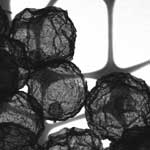 Among various nanomaterial candidates for water treatment, metal oxides have been widely used as removal agents for various heavy metal ions and their removal capacity was found to be relatively reliable. The removal mechanism for heavy metal ions is thought to be the formation of a strong bond between metal ions and metal oxide surfaces. This strong complexation is advantageous for complete removal of heavy metal ions but it presents a drawback if one wants to design a reusable agent by reviving the reaction site for heavy metal ions. Precisely because the removal mechanism is based on the strong complex formation between metal ions and oxide surfaces, recycling of these removal agents has proved to be difficult. Offering a potential solution, researchers have demonstrated a recyclable removal agent for heavy metal ions by fabricating a core-in-shell structure based on a core of carbon nanotubes and an iron oxide microcapsule structure.
Among various nanomaterial candidates for water treatment, metal oxides have been widely used as removal agents for various heavy metal ions and their removal capacity was found to be relatively reliable. The removal mechanism for heavy metal ions is thought to be the formation of a strong bond between metal ions and metal oxide surfaces. This strong complexation is advantageous for complete removal of heavy metal ions but it presents a drawback if one wants to design a reusable agent by reviving the reaction site for heavy metal ions. Precisely because the removal mechanism is based on the strong complex formation between metal ions and oxide surfaces, recycling of these removal agents has proved to be difficult. Offering a potential solution, researchers have demonstrated a recyclable removal agent for heavy metal ions by fabricating a core-in-shell structure based on a core of carbon nanotubes and an iron oxide microcapsule structure.
Mar 3rd, 2010
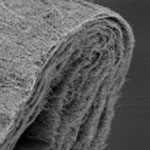 Materials engineers are keen to exploit the outstanding mechanical properties of carbon nanotubes for applications in fibers, composites, fabrics and other larger-scale structures and devices. The ability to fabricate continuous, multifunctional yarns represents an important step in this direction. The development of a continuous, weavable multilayered CNT yarn with superior mechanical, structural, surface, and electrical properties would open the way for a wide range of structural and functional applications, including composites, intelligent fabrics, catalyst supports, and sensors. Researchers in China now demonstrate the fabrication of a novel continuous yarn of CNTs with a multiple-layer structure by a CVD spinning process. The yarn consists of multiple monolayers of CNTs concentrically assembled in seamless tubules along the yarn axis.
Materials engineers are keen to exploit the outstanding mechanical properties of carbon nanotubes for applications in fibers, composites, fabrics and other larger-scale structures and devices. The ability to fabricate continuous, multifunctional yarns represents an important step in this direction. The development of a continuous, weavable multilayered CNT yarn with superior mechanical, structural, surface, and electrical properties would open the way for a wide range of structural and functional applications, including composites, intelligent fabrics, catalyst supports, and sensors. Researchers in China now demonstrate the fabrication of a novel continuous yarn of CNTs with a multiple-layer structure by a CVD spinning process. The yarn consists of multiple monolayers of CNTs concentrically assembled in seamless tubules along the yarn axis.
Feb 9th, 2010
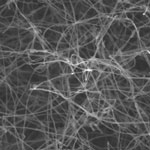 Carbon nanotubes are 'strange' nanostructures in a sense that they have both high mechanical strength and extreme flexibility. Deforming a carbon nanotube into any shape would not easily break the structure, and it recovers to original morphology in perfect manner. Researchers in China are exploiting this phenomenon by making CNT sponges consisting of a large amount of interconnected nanotubes, thus showing a combination of useful properties such as high porosity, super elasticity, robustness, and little weight. The nanotube sponges not only show exciting properties as a porous material but they also are very promising to be used practically in a short time. The production method is simple and scalable, the cost is low, and the sponges can find immediate use in many fields related to water purification.
Carbon nanotubes are 'strange' nanostructures in a sense that they have both high mechanical strength and extreme flexibility. Deforming a carbon nanotube into any shape would not easily break the structure, and it recovers to original morphology in perfect manner. Researchers in China are exploiting this phenomenon by making CNT sponges consisting of a large amount of interconnected nanotubes, thus showing a combination of useful properties such as high porosity, super elasticity, robustness, and little weight. The nanotube sponges not only show exciting properties as a porous material but they also are very promising to be used practically in a short time. The production method is simple and scalable, the cost is low, and the sponges can find immediate use in many fields related to water purification.
Feb 8th, 2010
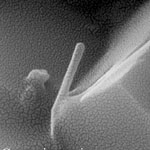 No other element in the periodic table bonds to itself in an extended network with the strength of the carbon-carbon bond. This special nature of carbon, combined with the molecular perfection of single-walled nanotubes endows these nanotubes with exceptional material properties, such as very high electrical and thermal conductivity, strength, stiffness, and toughness. As a result, single-walled carbon nanotubes (SWCNTs) are the strongest material known to science. SWCNTs potentially can add incredible strength, stiffness and electrical conductivity to all kinds of composite materials. Unfortunately, they are always held together in rope form due to their extremely small dimension and van der Waals attraction and their strength can neither be exploited nor measured. However, if several SWCNTs are concentrically nested in a confined space, the sliding issue can be resolved and the SWCNTs may share the applied tensile load to realize nanometer-scale materials remarkably stronger than the individual SWCNTs.
No other element in the periodic table bonds to itself in an extended network with the strength of the carbon-carbon bond. This special nature of carbon, combined with the molecular perfection of single-walled nanotubes endows these nanotubes with exceptional material properties, such as very high electrical and thermal conductivity, strength, stiffness, and toughness. As a result, single-walled carbon nanotubes (SWCNTs) are the strongest material known to science. SWCNTs potentially can add incredible strength, stiffness and electrical conductivity to all kinds of composite materials. Unfortunately, they are always held together in rope form due to their extremely small dimension and van der Waals attraction and their strength can neither be exploited nor measured. However, if several SWCNTs are concentrically nested in a confined space, the sliding issue can be resolved and the SWCNTs may share the applied tensile load to realize nanometer-scale materials remarkably stronger than the individual SWCNTs.
Dec 22nd, 2009
 Safe drinking water has been and increasingly will be a pressing issue for communities around the world. In developed countries it is about keeping water supplies safe while in the rest of the world it is about making it safe. The potential impact areas for nanotechnology in water applications are divided into three categories - treatment and remediation, sensing and detection, and pollution prevention. Within the category of sensing and detection, of particular interest is the development of new and enhanced sensors to detect biological and chemical contaminants at very low concentration levels. Testing of water against a spectrum of pathogens can potentially reduce the likelihood of many diseases from cancer to viral infections.
Safe drinking water has been and increasingly will be a pressing issue for communities around the world. In developed countries it is about keeping water supplies safe while in the rest of the world it is about making it safe. The potential impact areas for nanotechnology in water applications are divided into three categories - treatment and remediation, sensing and detection, and pollution prevention. Within the category of sensing and detection, of particular interest is the development of new and enhanced sensors to detect biological and chemical contaminants at very low concentration levels. Testing of water against a spectrum of pathogens can potentially reduce the likelihood of many diseases from cancer to viral infections.
Dec 8th, 2009
 It has been known for several years that carbon nanotubes would heat, ignite and luminesce upon exposure to certain types of electromagnetic radiation, including laser light. However, no one expected any form of fullerenes to do the same thing. Until now. A team at the University of Florida has discovered that functionalized fullerenes heat, ignite, glow and transform into other carbon nanostructures such as carbon nanotubes upon exposure to low-intensity laser light. This is the first time these findings have been published. A possible explanation for the optical heating and ignition phenomena that have been observed is a distortion of the symmetrical cage structure of the fullerenes.
It has been known for several years that carbon nanotubes would heat, ignite and luminesce upon exposure to certain types of electromagnetic radiation, including laser light. However, no one expected any form of fullerenes to do the same thing. Until now. A team at the University of Florida has discovered that functionalized fullerenes heat, ignite, glow and transform into other carbon nanostructures such as carbon nanotubes upon exposure to low-intensity laser light. This is the first time these findings have been published. A possible explanation for the optical heating and ignition phenomena that have been observed is a distortion of the symmetrical cage structure of the fullerenes.
 Subscribe to our Nanotechnology Spotlight feed
Subscribe to our Nanotechnology Spotlight feed





